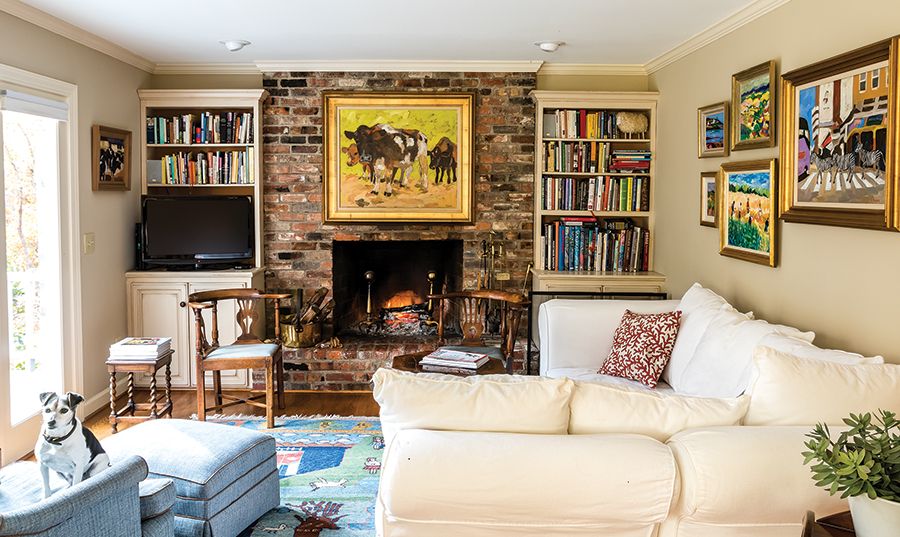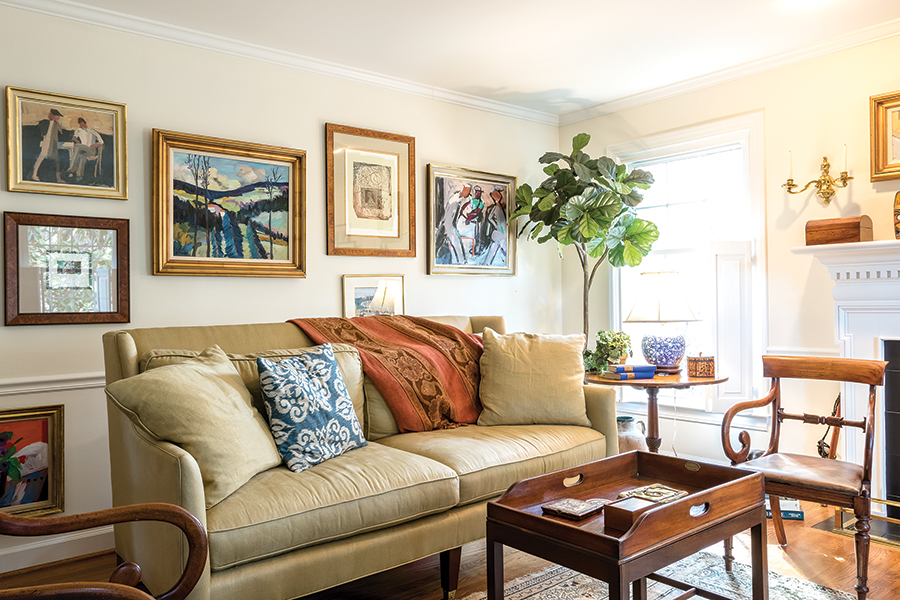
A place where nothing matches but everything belongs
By Deborah Salomon • Photographs by John Gessner
There’s something about Jessie Mackay’s house . . .
Outside, distressed bricks melt into the wooded 2-acre lot rather than jumping out onto the road that winds through Country Club of North Carolina.
Its contents — fewer heirlooms than souvenirs of a life well-traveled — begin their story in the soaring front hall, where hats hang on a coat tree:
“I wore the pith helmet when we rode horseback across Malawi into Zambia,” Jessie begins. Beneath the hats stand boots; Wellingtons speak of her life on a farm in the Cotswolds. On a campaign chest are arranged antique watch faces and a pipe picked up in France, a carved box from Hong Kong and cavalry spurs used by an ancestor. In the corner, a weathered Old Glory leans beside a Union Jack, affirming her dual citizenship. Although fascinating, these artifacts pale beside the paintings — everywhere: her own, those of friends, family members and fellow artists. Some, like a vibrant purple abstract by an Ecuadorian painter positioned on the upstairs gallery wall, attracted her purely for its color.

Jessie grew up in Westport, Connecticut, bordering Manhattan art and culture. She recalls attending a Van Gogh exhibit at the Guggenheim every day, “until (the staff) didn’t want to charge me admission.” Her British parents were casual painters. Jessie might have felt an inclination but, instead, followed a career in consultant management, which included measuring behaviors and results to enhance the workplace environment.
Well, Gauguin sailed with the merchant marines and Cézanne studied law.
Jessie dabbled a bit in high school. “After getting married I wanted something on the walls.” Her first inspiration came watching laborers in a British steel mill, admiring their physicality. The result, hanging in the living room, recalls grim early 20th century factory scenes immortalized by American artist Thomas Hart Benton.
Otherwise, Jessie identifies with Fauvism (think Matisse, its practitioner), defined, in part, as color existing as an independent element — intense blobs of it, rather than within finely drawn lines. “I felt painting was an outlet, a meditative thing,” she says. Not until early middle age did she make art her career. Her first show in Atlanta sold out. Her debut at Campbell House Galleries in Southern Pines moved 13 paintings, more than double the average.

Life, marriages, careers, activism took Jessie to various houses in many countries. In 2008 she was alone in Pinehurst, looking to downsize. Her first impression of the CCNC saltbox built in 1982: “Brick, ugly roof, sad, a mess inside.” Yet its bones and cross-hall two-story layout reminded her of New England while her design skills promised improvement. She and builder Buddy Tunstall made plans. First, the exterior. The painter had never done peeling brick, so they tried the obvious: spray with white paint, follow immediately with a pressure washing. Jessie recalls how the workmen laughed.
But it worked. So did the bright yellow door, the circular drive and informal landscaping. Back acreage, fenced for Jessie’s Jack Russell terriers, appears delightfully wild in the weak winter sun.
Inside, carpet was replaced by hardwood. Bathrooms needed remodeling — one in charming green toile wallpaper with graceful bureau-turned-washstand — but the three upstairs bedrooms remained intact.
Not so the main floor. Jessie decided to tear out several small rooms spanning the rear, including a dated kitchen, install an extra support beam and repurpose the space as her studio (with bay window), a long galley kitchen and small den with wood-burning fireplace. This was accomplished without dividers. The kitchen is beyond startling, since a guest walking through might not realize its purpose. On one side, an oven, a single-width refrigerator and cooktop niche are embedded in a brick wall. A polished harvest table used as both work island and seating is positioned down the middle with cabinets, drawers, sink, another bay window crowded with plants on the opposite side.
In the spring, a dogwood tree blooms just outside the bay.


“It reminds me of Europe — a lot of stuff, a lot going on,” Jessie explains. The brick provides a textured background for paintings, including the portrait of a friend dominating the south-facing studio with two easels, paints, brushes, stool and a portable typewriter. Locating her workspace adjoining the kitchen made sense. “I didn’t want to allocate a bedroom for a studio.”
Her office and laundry room line the hallway leading to the garage with doors not visible from the front.
Jesse misses her dogs, cats, horses and other creatures from what she called The Farm of Content Animals, since none of the ducks, chickens, geese, lambs or cows entered the food chain. Bovine portraits hang over the den fireplace, flanked by English corner chairs with leather seats and open sides to accommodate the sabers worn by officers.
Jessie courts a lived-in look. “Everything (these days) seems so contrived — a blanket draped just so over the couch,” she says, and points to a woolly throw in disarray on her own. “The dogs made that pile,” before falling asleep on it.

Jessie found the small living room both appealing and functional — especially after constructing bookcases across an entire wall. Half shutters on low-set windows continue the New England effect, although furnishings speak faraway tongues. The unusual high-backed sofa in Jessie’s favorite khaki is from a fine North Carolina manufacturer, but her leather-seated folding campaign chair (for easy transportation) experienced far-away battles. Facing it a plaid armchair with ottoman channels the ’60s. Each artifact on the mantel tells a story, each painting reveals a connection. Conversation never lags here.
“I wanted my dining room table to be wide enough,” Jessie says, to accommodate her stepsons and grandchildren. She chose one from Ireland, of yew wood, surrounded by Windsor chairs. Paintings lean against the wall, for decoration or perhaps awaiting a buyer.
Rugs throughout are, predictably, well-worn Orientals in subdued hues except for the den, where sheep gambol across a pastel background, to offset a shabby-chic white sofa.


Jessie admits to using the house as a supplemental gallery. “The problem for artists is that people don’t have wallspace any more,” she says. Her walls, painted gradations of white and framed by crown moldings, are covered but not saturated. Arrangements change as paintings sell. Emotional attachments don’t hinder business as with some artists: “There’s no sense of loss. Paintings are like children; when they’re 18, it’s time to go.”
Sometimes she follows them. Each year, Jessie returns to Tanzania, where she and friend Tally Bandy have established empowerment programs where women earn enough by raising pigs and goats to educate their children. To this endeavor they have added solar kits made in North Carolina, which enable the women to establish charging stations for lights and mobile phones. A few paintings reflect the African project.
So much life, in a moderate living space. “When I have a party we’re like puppies in a box,” the artist smiles. An elegant box, yet comfortable, inviting, with several areas to sit and chat, walls hung with oils and acrylics of varying shapes, moods, styles and expressions — even double entendre as with zebras crossing a busy thoroughfare.
Indeed, there’s something about Jessie Mackay’s house . . .
That something is Jessie Mackay. PS





